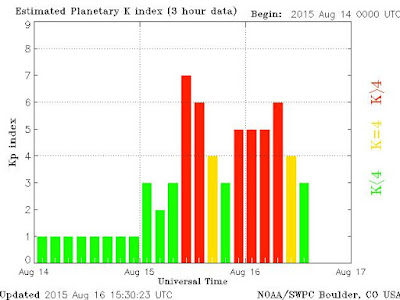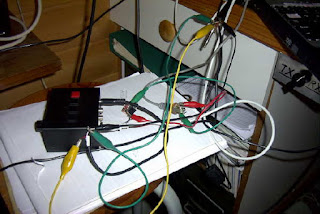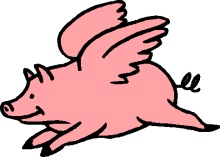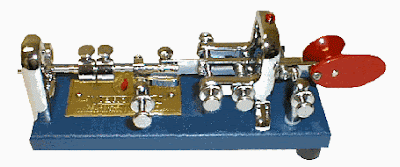Posts Tagged ‘CW’
 Frog Transceiver
Frog Transceiver
You will have doubtlessly heard about the super cheap Pixie QRP TXRX. Well for those feeling a little flush there is a (and always has been) a real high powered alternative knocking about on eBay. The Frog Transceiver is around the £8 mark at the moment and will give you about 1.5w on 40m and an evenings worth of fun putting it together.
 I’m off work this week for my summer hols and in between kayaking on the sea, being eaten alive in Ennerdale by voracious midges (my own fault for going there when there was no wind and not taking any insect repellent) I’d planned on assembling this little friend to add to my growing collection (along with the Pixie).
I’m off work this week for my summer hols and in between kayaking on the sea, being eaten alive in Ennerdale by voracious midges (my own fault for going there when there was no wind and not taking any insect repellent) I’d planned on assembling this little friend to add to my growing collection (along with the Pixie).
The PCB is as one would expect, not bad but not brilliant, components are fit for purpose but the packaging was a little shabby with everything just thrown in a bag, not much protection for the IC’s. So I’m getting my excuses in early….this might not work!
Still £8 is less than an evening at the pub, less than a trip to the cinema (for one) but more than a Pixie 
 The Best Laid Plans …
The Best Laid Plans …
 |
| courtesy: www.kcj-cw.com/ |
Hoping to enjoy some further contest work and improve my ear-brain-keyboarding skills, I had prepared everything for this Saturday's 24-hour 'KCJ' Contest. The 'Keymen's Club of Japan' is an annual affair that seems to attract a lot of domestic JA activity, with bonus points when they work any DX stations. I checked my N1MM Logger software but it didn't seem to have the contest. I did find it in the program's UDC (User Defined Contests) section but had to download and install a unique 'Sections' file from a Japanese website, as the contest requires the Japanese to exchange their Prefecture abbreviations. I eventually had N1MM working perfectly for the KCJ contest and with the contest starting at 0500 locally, I tuned up everything for the normally excellent 40m path to Japan in the morning and went to bed.
 |
| courtesy: http://www.swpc.noaa.gov/ |
The afternoon path never really materialized either. Normally, propagation between the west coast and Japan is very good, with lots of strong signals being the norm ... but not today. Over the course of several hours, only four JA stations found their way into my log, and they were all a struggle.
 |
| courtesy: http://wdc.kugi.kyoto-u.ac.jp/dstdir/index.html |
The earth had been hit, rather unexpectedly, by another whopping 'coronal hole stream' and propagation was truly dismal. With only a smidgen of keyboarding practice, I had to admit defeat ... the Sun had messed things up once again, as it has been doing for the past year as Cycle 24 slowly slides downhill. Unfortunately there is always a lot more flaring and streaming on the way down than on the way up. Hopefully the Sun will soon get this out of its system and radio conditions will quiet down and stabilize for the upcoming fall and winter DX season.
There is one more chance left, this evening, to get in some more keyboarding practice. The 'Flying Pigs QRP Group' holds their monthly 'Run For The Bacon' CW QSO party, starting at 0100Z tonight. Non-members may also join in the fun by sending their 'power' level instead of a membership number ... so maybe I'll run into you tonight.
Now it's back to N1MM to reconfigure for the QRP Party and hope that old Sol will co-operate for the Sunday night crowd, but you know what they say about the 'best laid plans...'
 SKCC Sprint
SKCC Sprint
 I've spent a couple of hours this weekend (so far mainly on Saturday), playing in the SKCC Sprintathon CW contest ... the rules demand that only hand keys, including bugs, be used. I hauled out my original gray Vibroplex, purchased back in 1964, when I decided that using a straight key was just too slow. I was doing a lot of DXing and contesting back then, with my trusty DX-20, VF-1 VFO and assorted groundplanes on top of my parents three-story house in the middle of Vancouver ... it's hard to believe that it was quiet enough there but those were the days before computers, switching power supplies and and so many other noise-making devices that we have today. They truly were the 'good old (quiet) days' of radio. My favorite contests back then were the 'W-VE', where any 'VE' became instant DX and the subject of good-sized pileups and the CW 'Sweepstakes' ... back when the exchange was, if I recall correctly, just NR, RST and QTH.
I've spent a couple of hours this weekend (so far mainly on Saturday), playing in the SKCC Sprintathon CW contest ... the rules demand that only hand keys, including bugs, be used. I hauled out my original gray Vibroplex, purchased back in 1964, when I decided that using a straight key was just too slow. I was doing a lot of DXing and contesting back then, with my trusty DX-20, VF-1 VFO and assorted groundplanes on top of my parents three-story house in the middle of Vancouver ... it's hard to believe that it was quiet enough there but those were the days before computers, switching power supplies and and so many other noise-making devices that we have today. They truly were the 'good old (quiet) days' of radio. My favorite contests back then were the 'W-VE', where any 'VE' became instant DX and the subject of good-sized pileups and the CW 'Sweepstakes' ... back when the exchange was, if I recall correctly, just NR, RST and QTH. My antenna farm sat on our high, peaked roof and consisted of groundplanes for 40m, 20m and 15m ... these were made of inexpensive galvanized drain pipe, about three or four inches in diameter. The 40m one was guyed and also had one end of my 80m dipole attached to it, which ran out across the yard and across the back lane, terminating on one of BC Hydro's wooden (telephone) poles. Every once in a while the telephone guys would take it off and toss it over the fence whereupon I would get out the ladder and re-attach it, where it would stay for another year or so.
For this weekend's CW party, I have put my 'Tri-Tet-Ten' on 20m, doubling from a 40m crystal to 14051.5, placing me pretty close to the Sprint's watering-hole QRG of 14050. I have had way too much fun with this simple one-tube radio since building it, mainly for 10m CW, in anticipation of the present solar cycle's peak years. Although it puts out almost 5W when quadrupling to 10m, I can get a whopping 13W from it on 20m, which is plenty of power to have some fun.
So far I've worked about 40 stations, all on CQ's, since I can't really QSY to answer others ... so if you are around this afternoon, please give me a call should you hear my little rig. It's a real nice change to hear non-machine sent CW for a change and fists ranging from one end of the scale to the other ... really a nice reminder of what the bands used to sound like when I first got on the air.
 Straight Key Century Club’s Weekend Sprintathon
Straight Key Century Club’s Weekend Sprintathon
 Can't wait 'til New Year's Eve's Straight Key Night? Enjoy CW as it has been sent since the earliest days of Amateur Radio in the SKCC Weekend Sprintathon! The SKCC regularly celebrates the joy of CW ... sent by either hand key or by bug:
Can't wait 'til New Year's Eve's Straight Key Night? Enjoy CW as it has been sent since the earliest days of Amateur Radio in the SKCC Weekend Sprintathon! The SKCC regularly celebrates the joy of CW ... sent by either hand key or by bug:The SKCC WES aims to bring together operators with different skill levels in a regularly scheduled, informal operating event lasting 36 hours. The event starts at 1200 UTC on the Saturday following the 6th of each month and ends at 2359 UTC on Sunday. Participants can operate for a total of no more than 24 hours. This event runs from 1200 UTC Aug. 8 to 23:59 UTC Aug. 9.
Non-members are encouraged to join in on the fun and, better yet, get an SKCC number by signing-up. Most of the action will congregate around the SKCC watering-hole frequencies:
Participants may sprint on 160-6 meters, excluding the WARC bands (60, 30, 17, and 12 meters). Suggested frequencies are on or around the SKCC calling frequencies: 1.820, 3.550, 7.055 and 7.114, 14.050, 21.050 and 21.114, 28.050 and 28.114, and 50.090 Mhz. K3UK's sked page or other spotting tools are permitted for this event.
I'll be on 20m for a few hours with my single 6L6 Tri-tet crystal oscillator running about 10 watts ... hopefully within a few KHz of 14.050, doubling from a 40m crystal along with my faithful Vibroplex, purchased as a teenager back in the early 60's.
For all of the details, visit the SKCC WES Rules page here ... so put away your keyers and have some real old fashioned radio fun.
 CW Contesting
CW Contesting
 |
| courtesy: http://k1el.tripod.com/ |
It's been a few years since I've done any CW contesting, mainly because the laptop I have always used became slow and sluggish as well as developing a keying glitch when keying was done via the serial port connection. Apparently it is, or was, a fairly common problem with some operating systems when serial port keying was employed.
Last year I purchased and built the WinKeyer USB keyer, mainly to use as a USB keying interface, and hopefully kill the keying stutter. The stutter would manifest itself in the form of delayed element spacing. For example, the 'C' in a 'CQ' would sound like 'NN'- every once in awhile ... not every time, but often enough to drive me crazy. From lots of 'Googling', I learned that USB keying should solve the problem.
The first thing I did was to download and run 'CCleaner' to scrub the computer of unused files and clean up the registry. My contesting laptop uses Windows XP, which I've always liked but my old system was taking about eight minutes to boot-up from a cold start! Following the CCleaner run, I did a hard drive defragmentation, shut the system down, and pressed the 'on' button. This time the system booted completely in less than two minutes, the fastest in several years!
After, interfacing everything with a half-dozen clip leads (I didn't have the required cables), configuring the WinKeyer and setting up the N1MM logging software for this weekend's NA CW QSO Party, I cautiously waded into the fray.
 |
| Yikes! |
Like riding a bicycle, it all came back to me quickly. The NA guys are hardcore CW fans and send fast, typically 30WPM or better. I started in the 'Search & Pounce' (S&P) mode to ease into the logging software's required keystrokes but soon felt comfortable enough to change to the 'Run' mode.
Handling the pileups and typing fast enough to keep up was challenging yet exhilarating ... it had been a few years since my last test, the 160m Stew Perry Contest, my favorite. I could only take the heat for so long and after about two hours of steady operating decided to call it a day. It was nice to shake out the new interface and also test my own skills once again. I completed my short test with 137 QSO's and 5891 points ... not much by 'NA' standards but still, for me, a ton of fun and a good 'back-in-the-saddle' re-start.
Now that the software is working well (there were zero keying glitches during the test), I'm looking forward to getting back into some CW contesting again and to improve my ear-brain-computer skills.
Time to get busy and build some interfacing cables and get rid of the clip-lead rat's nest for the next exercise.
Contesting events can be found at WA7BNM's excellent WA7BNM Contest Calender website
 The Joy Of CW
The Joy Of CW
 |
| courtesy: http://www.arrl.org/ |
I receive a lot of e-mail from both hams and future hams that are struggling with CW. It seems there are a lot of hams that don't operate any CW simply because of their code skills. For myself, learning CW as a pre-teen, was a bit of a struggle, as I learned CW from flash cards ... definitely the wrong way. In my case, the code was learned in order to operate an Aldis lamp signalling system for my scouting activities. When eventually switching to a hand key and buzzer, I had to make the mental switch between the picture of the flash card and the sound of the code, taking me much longer to reach my goals than if I had learned just by sound.
If I were learning the code today, or if advising anyone struggling with CW, I would suggest several ways of making it easier.
1. Too many newcomers want to learn CW using a keyer. Put the keyer away and get yourself a hand key. It need not be fancy or expensive.
2. Use the hand key to practice sending similar-sounding letters (E, I, S, H etc) slowly and correctly. Don't be concerned about sending them fast but concentrate on getting a uniform spacing between each element of the letter. As you slowly learn the letters and how they sound, you will find your sending speeding-up, unconsciously, as you progress.
3. Combine your sending practice with receiving practice and try to do 10 minutes of each during each practice session. One session per day will guarantee success, if you stick with it. If you can't do it every day then try and commit to every other day.
4. For receiving practice, use a much higher speed than what you are sending at. Once again, in sets of similar-sounding letters, try and learn the letters when sent at a speed of at least 15WPM, but with wide spaces between each letter ... so they aren't coming at you as fast. This is the Farnsworth method of learning code. Learning what the letters sound like when sent at a fast speed will eliminate the dreaded 'learning plateaus' associated with learning at slower speeds, when you can get stuck at a lower speed for some length of time. I only wish that I had known of this method when I was a kid, but I don't think it had been thought of back then.
5. There are lots of websites that will help you in Step 4 and one that I have played with seems to work very well. You can set up a slow-speed spacing but have characters sent at 15WPM or faster (start with 15WPM). You can pick only the letters that you wish to practice (T,M,O,A,N etc) and then get a printout of what was actually sent to check your accuracy. The one I tested is by AA9PW and can be found here.
In addition, the ARRL's W1AW, provides nightly code practice on various frequencies and also provides archived CW practice sessions at various speeds via their website here.
Once you become somewhat competent in both sending and receiving, don't be afraid to get on the air and use your new skills. Don't be concerned about sending fast and be careful about sending faster than you can receive, an easy trap to fall into.
There are always several stations around 7.110-7.125 every afternoon and evening that seem very happy to communicate at comfortable speeds. If you don't get on-the-air, then make sure that you still do your daily 20 minutes of practice. You will be amazed at how quickly you can learn the code or increase your speed, with this daily routine. This short daily commitment to practice (on the air or otherwise) is the key to success.
If you aren't using CW, you are missing out on a lot of fun. To this day, CW is still my favorite mode and almost 100% of my on-air operating is on CW ... it's just plain fun! Knowing how to use CW will open up a lot of opportunities to enjoy it ... CW contesting, chasing DX, CW nets, staying in touch with friends etc ... CW will always get through better than phone under most conditions.
 |
| courtesy: http://www.arrl.org/ |
So ... if you have been struggling with the code, or putting it off, there's no time like the present to join the fun. Hopefully you will find these suggestions helpful.
 CW Progress
CW Progress
Over 6 months ago I pretended to myself that I was going to learn CW. Just one QSO and then I can call myself a ‘real ham’.
Well I’ve had that QSO now and it seems reasonable to assume that I’ll have a few more now that I’m helping other local hams to learn CW. None of us are any good. I think I top out the speed tables at about 8-10wpm but now that there are a few more locals ready to take to the airwaves then I’m sure I’ll speed up to the target of 12-15wpm by Christmas.
So what? Well here’s the good news. 2m is as quiet as a mouse round here. Even the repeaters are empty so there’s no need to worry anyone with some troublesome sending.
Thursday nights are on air practice nights. Who knows, one day someone may not be part of the group and a real QSO might happen!














